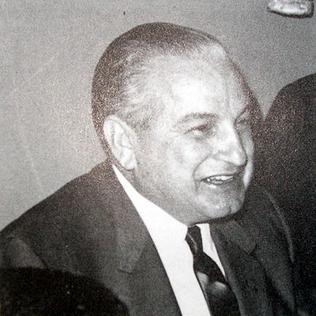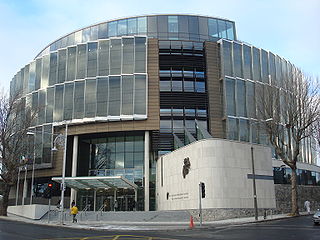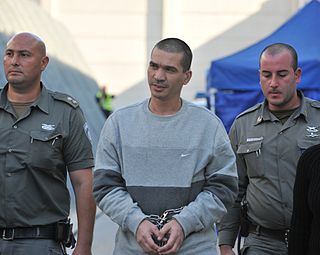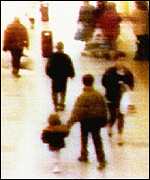The Genovese crime family, also sometimes referred to as the Westside, is an Italian-American Mafia crime family and one of the "Five Families" that dominate organized crime activities in New York City and New Jersey as part of the American Mafia. They have generally maintained a varying degree of influence over many of the smaller mob families outside New York, including ties with the Philadelphia, Patriarca, and Buffalo crime families.

Joseph Theodore Leslie "Squizzy" Taylor was an Australian gangster from Melbourne. He appeared repeatedly and sometimes prominently in Melbourne news media because of suspicions, formal accusations and some convictions related to a 1919 gang war, to his absconding from bail and hiding from the police in 1921–22, and to his involvement in a robbery where a bank manager was murdered in 1923.

Carlos Joseph Marcello ;[Mor-sel-lo] born Calogero Minacore ; February 6, 1910 – March 3, 1993) was an Italian-American crime boss of the New Orleans crime family from 1947 to 1983.

Arthur Thompson was a Scottish gangster who was active in Glasgow from the 1950s and took charge of organised crime in the city for over thirty years.

The Special Criminal Court is a juryless criminal court in Ireland which tries terrorism and serious organised crime cases.
Leonard Arthur McPherson was one of the most notorious and powerful Australian career criminals of the late 20th century. McPherson is believed to have controlled most of Sydney's organised crime activity for several decades, alongside his contemporary Abe Saffron and associate, bookmaker George Freeman.
In England and Wales, life imprisonment is a sentence that lasts until the death of the prisoner, although in most cases the prisoner will be eligible for early release after a minimum term set by the judge. In exceptional cases a judge may impose a "whole life order", meaning that the offender is never considered for parole, although they may still be released on compassionate grounds at the discretion of the Home Secretary. Whole life orders are usually imposed for aggravated murder, and can only be imposed where the offender was at least 21 years old at the time of the offence being committed.
The Irish Mob is a usually crime family–based ethnic collective of organized crime syndicates composed of primarily ethnic Irish members which operate primarily in Ireland, the United States, the United Kingdom, Canada and Australia, and have been in existence since the early 19th century. Originating in Irish-American street gangs – famously first depicted in Herbert Asbury's 1927 book, The Gangs of New York – the Irish Mob has appeared in most major U.S. and Canadian cities, especially in the Northeast and the urban industrial Midwest, including Boston, New York City, Philadelphia, Pittsburgh, Baltimore, Cleveland, and Chicago.

HM Prison Barlinnie is the largest prison in Scotland. It is operated by the Scottish Prison Service and is located in the residential suburb of Riddrie, in the north east of Glasgow, Scotland. It is informally known locally as The Big Hoose, Bar and Bar-L. In 2018, plans for its closure were announced.

The ice cream wars were turf wars in the East End of Glasgow, Scotland, in the 1980s between rival criminal organisations selling drugs and stolen goods from ice cream vans. Van operators were involved in frequent violence and intimidation tactics, the most notable example of which involved a driver and his family who were killed in an arson attack that resulted in a twenty-year court battle. The conflicts generated widespread public outrage, and earned the Strathclyde Police the nickname of "Serious Chimes Squad" for its perceived failure to address them.
Thomas "Tam" McGraw, also known as "The Licensee" or "Wan-Baw McGraw", was a gangster involved in organised crime including extortion and drug trafficking in Glasgow, Scotland.

The Abergil Organization is an Israeli organized crime syndicate that has been active since the late 20th and early 21st centuries. The organization was founded by brothers Yaakov and Avi Abergil in the city of Ramat Gan, Israel, in the 1990s. The Abergil Organization is involved in a wide range of criminal activities, including drug trafficking, money laundering, and extortion.

Peter Britton Tobin was a Scottish convicted serial killer and sex offender who served a whole life order at HM Prison Edinburgh for three murders committed between 1991 and 2006. Police also investigated Tobin over the deaths and disappearances of other young women and girls.

On 12 February 1993 in Merseyside, two 10-year-old boys, Robert Thompson and Jon Venables, abducted, tortured, and murdered a two-year-old boy, James Patrick Bulger. Thompson and Venables led Bulger away from the New Strand Shopping Centre in Bootle, after his mother had taken her eyes off him momentarily. His mutilated body was found on a railway line two and a half miles away in Walton, Liverpool, two days later.
The Commisso 'ndrina is a powerful clan of the 'Ndrangheta, a criminal and mafia-type organization in Calabria, Italy. The 'ndrina is based in Siderno, but also has a branch in the Greater Toronto Area in Canada as part of the Siderno Group. The Commisso clan is involved in international drug trafficking using family ties in Italy, Canada, the United States and Australia.

The Wee Man, also released as John Burns, is a 2013 British gangster film directed by Ray Burdis and starring Martin Compston and John Hannah. It depicts the true life story of Scottish criminal Paul Ferris.
Frank Samuel Mitchell, also known as "The Mad Axeman", was an English criminal and friend of the Kray twins who was later murdered at their behest.
The Glasgow pub bombings were two bomb attacks in Glasgow, Scotland, carried out by the Ulster Volunteer Force (UVF) on 17 February 1979. The UVF bombed two pubs frequented by Catholics: the Old Barns in Calton and, 15 minutes later, the Clelland Bar in Gorbals. Five people were injured, all at the Clelland Bar. The pubs were targeted because they were allegedly used for fundraising for Irish republicans in Northern Ireland. The attack sparked fears that sectarian terrorism would erupt in Scotland as a spillover of the Troubles. Experts believe a Provisional Irish Republican Army (IRA) veto on bombing operations in Scotland prevented the situation from escalating because the country was a center of IRA support in terms of fundraising, safe houses, and gun-running.

Ian Douglas McAteer is a Scottish former gangster who was a prominent figure in the Glasgow and Liverpool criminal underworlds during the later 20th century. McAteer accumulated various convictions, and in 2001 was sentenced to life for the 1999 murder of a gangland associate; he had been acquitted of a previous murder charge in 1998. McAteer was a suspect in other crimes, including the 1999 murder of television presenter Jill Dando.

Joseph Henry Pyle, known as Joey Pyle or Joe Pyle, was an English gangland boss, convicted criminal, and pioneer and promoter of unlicensed boxing, who operated in London from the 1950s until his final arrest and conviction in 1992. An associate of the Krays and the Richardsons, and "one of the most feared members of the London underworld", he was known as the "London Don of Dons" by the New York Mafia. Less well known to the general public than many of his contemporaries in the underworld, Pyle was a key police target during his criminal career, but although arrested and charged many times, he seldom served time in prison, unlike many of the gangland figures with whom he was associated.












